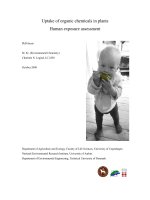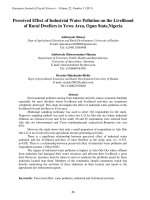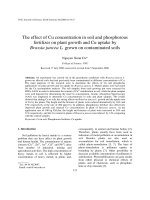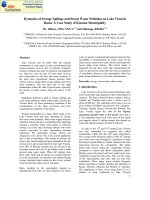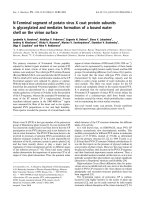Perceived Effect of Industrial Water Pollution on the Livelihood of Rural Dwellers in Yewa Area, Ogun State,Nigeria ppt
Bạn đang xem bản rút gọn của tài liệu. Xem và tải ngay bản đầy đủ của tài liệu tại đây (207.58 KB, 10 trang )
European Journal of Social Sciences – Volume 22, Number 1 (2011)
66
Perceived Effect of Industrial Water Pollution on the Livelihood
of Rural Dwellers in Yewa Area, Ogun State,Nigeria
Adebowale Oluseyi
Dept of Agricultural Extension and Rural Development, University of Ibadan
E-mail:
Tel: +2348132965488
Adebowale Oluwawemimo Oluseun
Department of Veterinary Public Health and Reproduction,
University of Agriculture, Abeokuta
E-mail:
Tel: +2348069181481
Oyesola Olutokunbo Birdie
Dept of Agricultural Extension and Rural Development,University of Ibadan
E-mail:
Tel:+2348023250458
Abtract
Environmental pollution arising from industrial activities causes economic hardship
especially for rural dwellers whose livelihood and livelihood activities are sometimes
completely destroyed. This study investigates the effect of industrial water pollution on the
livelihood of rural dwellers in Yewa area.
Multistage sampling technique was used to select 182 respondents for the study.
Purposive sampling method was used to select two L.G.As:Ado odo ota (where industrial
effluents are released rivers) and Yewa south. 90 and 92 respondents were selected from
Ado odo ota (downstream) and Yewa south(upstream) respectively.Response rate was
95%.
However the study shows that only a small proportion of respondents in Ado Odo
Ota L.G.A are involved in non agricultural income generating activities.
There is a significant relationship between perceived effect of industrial water
pollution and the livelihood activities of rural dwellers in the study area. (r= -0.253,
p<0.05). There is a relationship between perceived effect of industrial water pollution and
respondents income (-196,p>0.05).
The impact of industrial water pollution is highest in Ado Odo Ota where effluent
from industries had damaged their water resources and affected their livelihood a great
deal. However, measures must be taken to stem or eradicate the problems posed by these
industries located near them. Members of the community should community watch dog
directly monitoring the activities of these industries in their locality and report to the
appropriate law enforcement agents.
Keywords: Perceived effect, water pollution, industrial and livelihood activities.
European Journal of Social Sciences – Volume 22, Number 1 (2011)
67
1. Introduction
Environmental problems have become a key issue globally. The environment and its significance on
human life have increasingly come to national and international dimension.
Industrial pollution is a major environmental problem in Nigeria. It arises from lack of proper
control of pollutant industries. Increased development of land for industrial use received greater
impetus in the post independence era when national industrial policy revolved around import
substitution as a panacea for the unfavourable terms of trade that Nigeria feature textiles, breweries,
leather , tanning, pulp and paper industries, detergent, steel, etc., all of which have implications for
overall quality in the affected areas. Most industries that have the potential of seriously degrading the
environment are largely urban-based (Magbagbeola,2001).
Ideally, the sitting of industries should achieve a balance between socio- economic and
environmental considerations. Relevant factors are availability and access to raw materials, the
proximity of water sources, a market for the products, the cost of effective transportation, and the
location of major settlement, labour and infrastructural amenities. In developing countries such as
Nigeria, the siting of industries is determined by various criteria, some of which are environmentally
unacceptable and pose serious threats to public health (WHO/UNEP, 1997).
Industrialization, with its economic growth and prosperity can also bring unintended and
adverse effects to the natural resources and livelihoods of farmers/ rural dwellers within the vicinity.
This is an act of one agent affecting the live and livelihood of the other who are no way responsible for
the act. In this case the farmers and rural dwellers are no way responsible for the water pollution done
by the concerned industries.
Air, soil and water pollution frequently reduce agricultural yields, lower health status, increase
the prices that consumers of agricultural product must pay and after the returns accruing to owners of
agricultural inputs and increase morbidity pattern of the population (Adam and Crodar, 1991, Somorin,
1998). the effects of pollution can however, reveal themselves in many ways. Depending on their
nature, the results can be felt over long distance. A critical aspect is water pollution, which can affect a
river system for many Kilometers downstream from the point of release of pollutants.
Industrial waste water constants chemicals and biological matter that impose high demand on
the oxygen present in water.Polluted water thus contains ion levels of dissolved oxygen demand
(BOD) and chemical oxygen demand (COD) placed by industries …discharged into water bodies and
water systems, but above and below the earth surface. In addition to low levels of dissolved oxygen in
water, industrial wastes (Effluents) also contain chemicals and metals that are directly harmful to
human health and the ecosystem. (SIDA 1990). Apart from health effects, which indirectly affect
human productivity, polluted water also affects land productivity. Crop production suffers from
contaminated irrigation water from both surface sources and from ground water splifers.
Consequently, the following objectives where addressed in this study:
a) Identify the socio-economic and personal characteristics of dwellers in yewa area Ogun
State.
b) Identify the livelihood activities of rural dwellers in the study area.
c) Determine the rural dwellers knowledge of environmental problems in caused by effluents
from the industries in study area.
2. Methodology
This study was conducted in Arobieya, Itele, Igbango, Itele, Abila and Oloya villages of Ado Odo Ota
L.G.A and Idogo, Eggua, Oka Odan , Eyekose villages of Yewa south. Yewa South, two of the three
(Yewa North inclusive) local government areas that make up Yewa area of Ogun state,Nigeria. The
Yorubas are the major inhabitants. Farming and trading are the predominant occupations similar to the
occupations of about 52% of the Nigerian population who are living in rural and semi urban
communities (Olusimbo et al,2010).
European Journal of Social Sciences – Volume 22, Number 1 (2011)
68
Multistage sampling method was used to select 182 respondents from the two purposively
selected L.G.A in Yewa area. Stratified sampling and purposive sampling techniques were used to
select two LGA from the three L.G.As of Yewa area (comprising Ado odo ota, Yewa south and Yewa
North).Ado Odo Ota (downstream) and Yewa south(upstream) were selected because the former host a
number of various effluents releasing industries with specialities ranging from distilleries, battery
production, asbestos making ,brewery etc some of these are located in the villages mentioned above
while the later has no known industry. Proportionate and simple random sampling technique were used
to select 91 respondents in Ado Odo Ota where there are industries and 92 in Yewa South with no
known industries. A total of 183 where randomly selected from these communities. Information on the
socio economic characteristics, livelihood activities, effect of industrial water pollution were collected
using a pretested structured questionnaire. The response rate was 95%. Five-point Likert-scaled items
were used to measure the effect of industrial water pollution. Mean value of each item were generated
and use to get the level of impact of the effect of industrial pollution on the rural dwellers in the study
areas. An interviewer assisted method was employed, after informed consent had been obtained from
the respondents. Six trained personnel collected data over a 4 week period in August 2010.
Data was analyzed with SPSS version 15.0 (SPSS Inc,Chicago, Illinois). Frequencies were
generated and associations explored with Chi-square tests and ANOVA. The level of significance was
set to 5%.
3. Result and Discussion
Table 1: Respondents’ socio economic distribution.
Age Category (Years)
Ado Odo Ota LGA Yewa South LGA Yewa Area (Total)
Freq (%) Freq (%) Freq (%)
Less than 26 8 (4.6) 3 (1.7) 11(5.3)
26-30 6 (3.5) - 6(3.5)
31-35 13 (7.5) 8 (4.6) 21(12.1)
36-40 8 (4.6) 8 (4.6) 16(9.2)
41-45 13 (7.5) 11 (6.3) 24(13.8)
46-50 3(1.7) 16 (9.2) 19(10.9)
51-55 9(5.0) 11 (6.4) 20(11.6)
56-60 6(3.5 8 (4.6) 14(8.1)
Above 6 1 16(9.3) 19(11.9) 19(20.3)
Sex
Male 36(20.8) 52(30.1) 88(50.9)
Female 42(24.3) 31(17.9) 73(42.2)
Marital status
Never married - 3(1.7) 3(1.7)
Married 76(43.9) 76(43.9) 152(87.8)
Separated/Divorce 2(1.2) 2(1.2) 4(2.3)
Widow 1(0.6) 3(1.7) 4(2.3)
Educational status
No formal 7(4.1) 13(7.5) 20(11.6)
Primary 4(2.3) 13(7.5) 20(11.6)
Modern 1(0.6) 22(12.7) 23(23.3)
Secondary 66(38.1) 20(11.6) 86(46.7)
Grade II - 3(1.7) 3(1.7)
Tertiary - 8(4.6) 8(4.6)
Source: Field Survey,2010.
3.1. Personal Characteristics of Respondents
Table 1 shows that there are more respondents between the age of 19 and 40 years in Ado Odo Ota
L.G.A(20.2%) than Yewa south L.G.A(10.9%). This could be due to the proximity of the area to the
European Journal of Social Sciences – Volume 22, Number 1 (2011)
69
industrial areas of Ado Odo Ota L.G.A which attracts more of youths as workers.This is an indication
that there are more youths in the industrial area of Ado Odo Ota L.G.A than Yewa south L.G.A.
The table further reveals that majority of the respondents (87.9%) are married. The trend is
similar in all the study areas Yewa south (43.9%) and Ado Odo Ota(43.9%). Akibile,2007 asserted
that” marriage is an important factor in the livelihood of individuals. While those that are single
consider the wellbeing of not only themselves but also of other members of the household”. These
assertion was corroborated by the findings in Table 1.
Table 1 also reveals that there are 20.8% of male in Ado Odo Ota L.G.A and 30.1% account for
the number of female. This could be attributed to more female headed family due to their spouse
movement(in search of factory and other jobs) to urban industrial area of Sango Ota.
A total of 11.6% of respondents have no formal education, while the remaining has one form of
education or the other while only 4.6% has tertiary education.
3.1.1. Perceived Effect of Industrial Pollution on Livelihood of Rural Dwellers in Yewa Area,
Ogun State N = 173
Table 2: Distribution of Respondents by their level of agreement on their perceived effect of industrial
pollution on Livelihood of rural dwellers’ in Yewa area,Ogun State
S/N
Perceptional Statements about perceived
effect of industrial pollution on Livelihood
Level of Rural Dwellers Agreement
SD D U A SA MEAN
Freq (%) Freq (%) Freq (%) Freq (%) Freq (%) Freq (%)
1.
The water from streams always causes health
problems for one or two people in the
household/community
37(21.4) 46(26.6) 6(3.5) 8(4.6) 73(42.2) 2.8
2.
More of well water is used for drinking purpose
now because it is more safe
5(2.9) 16(9.2) 4(2.3) 103(59.5) 42(24.3) 2.05
3.
Household members do not go to farm/work
when sick
- - 37(21.4) 57(32.9) 76(43.9) 1.77
4.
Farm productivity has decreased over the last 10
years
7(4) 32(18.5) 38(18.5) 56(32.4) 36(20.8) 2.52
5.
Farms need more fertilizer application (both
organic and inorganic) to support more crop
yield.
31(17.9) 10(5.8) 22(12.7) 64(37) 43(24.9) 2.54
6.
Skin itches more than it use to over the last 10
years
34(19.7) 42(24.3) 27(15.6) 51(29.5) 15(8.7) 3.17
7.
Health hazards posed by industrial activities
result in rural dwellers/farmers spending more
to maintain their health
28(16.2) 17(9.8) 61(35.3) 28(16.2) 36(20.8) 2.84
8.
More money is spent to provide the things the
industries should have provided our
communities (spent more to get safe drinking
water).
29(16.8) 20(11.6) 79(45.7) 24(13.9) 16(9.2) 3.13
9.
The income generated from selling bush meat
are no longer coming because noise and unsafe
drinking water have scared wild animals aw
36(20.8) 48(27.7) 35(20.2) 34(19.7) 17(9.8) 3.31
10.
Our old men suffer more of Alzheimer’s disease
and Parkinson disease
49(28.3) 49(28.3) 28(16.2) 18(10.4) 25(14.5) 3.47
11. More pregnancy are recorded now than before 11(6.4) 29(16.8) 30(17.3) 45(26) 52(30.1) 2.41
12.
The source of drinking water makes us more
tired and nauseated and loss appetite
47(27.2) 48(27.7) 21(12.1) 35(20.2) 19(11) 3.41
13.
More miscarriages are experienced now than in
the last 20 years
35(20.2) 47(27.2) 40(23.1) 24(13.9) 40(23.1) 3.41
14.
Children are no longer staying to cultivate land
because of the effect of pollution
9(5.2) 62(35.8) 31(17.9) 27(15.6) 53(30.6) 3.28
15.
Stream are not contaminated, therefore they are
good for irrigation
10(5.8) 35(20.2) 18(10.4) 54(31.2) 53(30.6) 2.38
16.
The risk of health and crop failure is increasing
by the day
59(34.1) 49(28.3) 18(10.4) 23(13.3) 20(11.6) 3.62
17.
People live longer here than the communities
where there are no industries
33(19.1) 20(11.6) 45(26) 15(8.7) 57(32.9) 2.75
Overall mean of Rural Dwellers level of
Agreement
2.87
Source: Field Survey,2010.
European Journal of Social Sciences – Volume 22, Number 1 (2011)
70
Table 2 shows rural dweller agreement with statement about the perceived affect of industrial
pollution from the table , the following assertions are attributed to respondents. Note: SA and A where
added to get a sum level of agreement among respondent.
a. The industrial activities around the study area coupled with it resultant environment
problems have being perceived to have negative impact on their steams which always cause
health problem for one or two people in their household (46.8%) as indicated by respondent
and this causes respondents to miss a few numbers of days at work/farm (76.8%).
b. Their activities have so much impacted their steams such that rural dweller has switch to the
use of well water (83.8%). That effect has lead to decrease in farm productivity over the last
10 years (53.2%).
c. Individual health of rural dwellers in around the study area is affect such as more itching of
skin (48.2%); possibly contributed a great deal to miscarriage experienced by females
(37.2%).
d. Farm needs more fertilizer to support crop yield because of the effect of industrial pollution
(61.9%).
3.1.2. Perceived Effect of Industrial Pollution on Livelihood of Rural Dwellers Around Ado Odo
Ota Local Government Area N = 82.
Table 3: Distribution of Respondents by their level of agreement on their perceived effect of industrial
pollution on Livelihood of rural dwellers in Ado Odo Ota L.G.A N=82
S/N
Perceptional Statements about perceived effect of industrial
pollution on Livelihood
Level of Rural Dwellers Agreement
SD D U A SA MEAN
Freq
(%)
Freq
(%)
Freq
(%)
Freq
(%)
Freq
(%)
1.
The water from streams always causes health problems for one or
two people in the household/community
- - 2(2.4) 7(8.5) 73(89) 4.9
2.
More of well water is used for drinking purpose now because it is
more safe
- - - 76(92.7) 6(7.3) 4.1
3. Household members do not go to farm/work when sick - - 30(36.6) 10(12.2) 42(51.2) 1.9
4. Farm productivity has decreased over the last 10 years - 10(12.2) 14(17.1) 28(34.1) 30(36.6) 4.0
5.
Farms need more fertilizer application (both organic and
inorganic) to support more crop yield.
5(6.1) 2(2.4) 18(22) 36(43.9) 21(25.6) 3.8
6. Skin itches more than it use to over the last 10 years 2(2.4) 6(7.3) 23(28) 35(42.7) 15(18.3) 3.6
7.
Health hazards posed by industrial activities result in rural
dwellers/farmers spending more to maintain their health
3(3.7) 5(6.1) 12(14.6) 27(32.9) 35(42.7) 4.1
8.
More money is spent to provide the things the industries should
have provided our communities (spent more to get safe drinking
water).
2(2.4) 3(3.7) 36(43.9) 24(29.3) 15(18.3) 3.5
9.
The income generated from selling bush meat are no longer
coming because noise and unsafe drinking water have scared
wild animals aw
1(1.2) 14(17.1) 17(20.7) 33(40.2) 17(20.7) 2.4
10.
Our old men suffer more of Alzheimer’s disease and Parkinson
disease
8(9.8) 12(14.6) 24(29.3) 16(19.5) 21(25.6) 3.3
11. More pregnancy are recorded now than before 4(4.9) 11(13.4) 20(24.4) 15(18.3) 31(37.8) 3.7
12.
The source of drinking water makes us more tired and nauseated
and loss appetite
3(3.7) 9(11) 17(20.7) 34(41.5) 19(23.2) 3.7
13. More miscarriages are experienced now than in the last 20 years 2(2.4) 11(13.4) 25(30.5) 22(26.8) 22(26.8) 3.6
14.
Children are no longer staying to cultivate land because of the
effect of pollution
2(2.4) 15(18.3) 25(30.5) 20(24.4) 20(24.4) 2.5
15.
Stream are not contaminated, therefore they are good for
irrigation
8(9.8) 24(29.3) 15(18.3) 16(19.5) 19(23.2) 2.8
16. The risk of health and crop failure is increasing by the day
33(40.2) 10(12.2) 12(14.6) 16(19.5) 10(12.2) 2.5
17.
People live longer here than the communities where there are no
industries
14(17.1) 8(9.8) 3(3.7) 11(13.4) 46(56.1) 3.8
Overall mean of Rural Dwellers level of Agreement 3.4
Source: Field Survey, 2010.
European Journal of Social Sciences – Volume 22, Number 1 (2011)
71
Table 4: Distribution of Respondents by their level of agreement on their perceived effect of industrial
pollution on Livelihood of rural dwellers in Yewa South L.G.A N=91
S/N
Perceptional Statements about perceived effect
of industrial pollution on Livelihood
Level of Rural Dwellers Agreement
SD D U A SA MEAN
Freq (%) Freq (%) Freq (%) Freq (%) Freq (%)
1.
The water from streams always causes health
problems for one or two people in the
household/community
37(40.7) 46(50.5) 4(4.4) 1(1.1) - 1.6
2.
More of well water is used for drinking purpose
now because it is more safe
5(5.5) 16(17.6) 4(4.4) 27(29.7) 36(39.6) 3.7
3.
Household members do not go to farm/work when
sick
- - 7(7.7) 47(51.6) 34(37.4) 1.6
4.
Farm productivity has decreased over the last 10
years
7(7.7) 22(24.2) 24(26.4) 28(30.8) 6(6.6) 2.9
5.
Farms need more fertilizer application (both
organic and inorganic) to support more crop yield.
26(28.6) 8(8.8) 4(4.4) 28(30.8) 22(24.2) 3.0
6.
Skin itches more than it use to over the last 10
years
32(35.2) 36(39.6) 4(4.4) 16(17.6) - 2.0
7.
Health hazards posed by industrial activities result
in rural dwellers/farmers spending more to
maintain their health
25(27.5) 12(13.2) 49(53.8) 12(13.2) 25(27.5) 2.3
8.
More money is spent to provide the things the
industries should have provided our communities
(spent more to get safe drinking water).
27(29.7) 17(18.7) 43(47.3) - 1(1.1) 2.1
9.
The income generated from selling bush meat are
no longer coming because noise and unsafe
drinking water have scared wild animals aw
35(38.5) 34(37.4) 18(19.6) 1(1.1) - 4.0
10.
Our old men suffer more of Alzheimer’s disease
and Parkinson disease
41(45.1) 37(40.7) 4(4.4) 2(2.2) 4(4.4) 1.7
11. More pregnancy are recorded now than before 7(7.7) 18(19.8) 15(16.5) 30(33) 21(23.1) 3.3
12.
The source of drinking water makes us more tired
and nauseated and loss appetite
44(48.4) 39(42.9) 6(6.6) 1(1.1) - 1.5
13.
More miscarriages are experienced now than in the
last 20 years
33(36.3) 36(39.6) 3(3.3) 2(2.2) 1(1.1) 1.8
14.
Children are no longer staying to cultivate land
because of the effect of pollution
7(7.7) 47(51.6) 6(6.6) 7(7.7) 20(22) 3.0
15.
Stream are not contaminated, therefore they are
good for irrigation
2(2.2) 11(12.1) 3(3.3) 38(41.8) 34(37.4) 1.9
16.
The risk of health and crop failure is increasing by
the day
26(28.6) 39(42.9) 6(6.6) 7(7.7) 10(11) 2.2
17.
People live longer here than the communities
where there are no industries
19(20.9) 12(13.2) 42(46.2) 4(4.4) 11(12.1) 2.6
Overall mean of Rural Dwellers level of
Agreement
2.4
Source: Field Survey,2010.
The overall mean of rural dwellers level of agreement among respondents in Ado Odo Ota is
more than Yewa south
3.2. Livelihood and Livelihood Activities
This section presents the discussion of the findings on the various livelihood activities (agricultural and
non-agricultural income generating engaged in by rural dwellers in Yewa area, Ogun State.
3.2.1. Agricultural Income Generating Activities
Types of agricultural income generating activities, degree involvement and importance of the
activities to rural dwellers in Yewa area, Ogun State.
European Journal of Social Sciences – Volume 22, Number 1 (2011)
72
Table 5: Types of Agricultural income generating activities, involvement,degree of involvement and
importance of the activities in rural dwellers in Yewa area. N=173
S/N Agricultural Activities
Involvement
Degree of Involvement Importance
High Moderate Low Most Important
Freq (%) Freq (%) Freq (%) Freq (%) Freq (%)
1 Rice production 12(6.9) 5(2.9) 3(1.7) 4(2.3) 5(2.9)
2. Cocoyam production 37(21.4) 4(2.3) 30(17.3) 3(1.7) 6(3.5)
3. Green vegetables production 29(16.8) 10(5.8) 11(6.4) 10(5.8) 4(2.3)
4. Pepper production 57(32.9) 13(7.5) 30(17.3) 11(6.4) 8(4.6)
5. Tomatoes production 36(20.8) 13(7.5) 8(4.6) 14(8.1) 6(3.5)
6. Cassava peeling 29(16.8) 20(11.6) 6(3.5) 2(1.2) 4(2.3)
7. Gari frying 45(26) 20(11.6) 8(4.6) 16(9.2) 10(5.8)
8. Fufu making 25(14.5) 14(8.1) 3(1.7) 9(5.2) 4(2.3)
9. Goat rearing 46(26.6) 9(5.2) 24(13.9) 15(8.7) 14(8.1)
10. Cattle rearing 15(8.7) 4(2.3) 4(2.3) 5(2.9) 9(5.2)
11. Pig rearing 28(16.2) 7(4) 15(8.7) 4(2.3) 8(4.6)
12. Rabbit production 9(5.2) 1(0.6) 5(2.9) 4(2.3) 7(4.0)
13. Table egg production 11(6.4) 3(1.7) 3(1.7) 5(2.9) 9(5.2)
14. Broilers production 9(5.2) 1(0.6) 2(1.2) 6(3.5) 8(4.6)
15. Fishing 43(24.9) 12(6.9) 26(15) 5(2.9) 2(1.2)
16. Kolanut processing 12(6.9) 3(1.7) 7(4) 1(0.6) -
17. Sugarcane Production 10(5.8) 2(1.2) 1(0.6) 7(4) 9(5.2)
18. Yam 4(2.3) - - 1(0.6) 1(0.6)
19. Sorghum 2(1.2) - 1(0.6) - 1(0.6)
20. Cocao Production 19(11) 8(4.6) 9(5.2) - 9(5.2)
21. Maize 46(26) 25(14.5) 18(10.4) 6(3.5) 13(7.5)
22. Oil palm 4(2.3) 4(2.3) - - -
23. Cucumber 2(1.2) 2(1.2) - - 1(0.6)
24. Water melon 1(0.6) 1(0.6) - - -
25. Cassava 39(22.5) 5(2.9) 20(11.6) 11(6.4) 7(4)
Source: Field Survey,2010.
This finding corroborated with the assertion of Akinbile and Omotara (2000) that maize is one
of the important crops that respondents grow in order to boost their income. Table 5 also shows that
degree of involvement in these activities it shows that there is relative high involvement in maize
production (14.5%), cassava production (11.6%), Gari frying (11.6%).
Types of agricultural income generating activities, degree of involvement and importance
of activities to rural dwellers around (Ado Odo Ota) Local Government Area.
Table 6: Types of Agricultural income generating Activities, Involvement and degree of involvement and
importance of activities to rural dwellrs in Ado Odo Ota L.G.A. N=82
S/N Agricultural Activities
Involvement
Degree of Involvement Importance
High Moderate Low Most Important
Freq (%) Freq (%) Freq (%) Freq (%) Freq (%)
1 Rice production - - - - -
2. Cocoyam production 2(2.4) - 2(2.4) - 2(2.4)
3. Green vegetables production 5(6.1) - - 7(8.8) 2(2.4)
4. Pepper production 13(15.9) - 3(3.7) 6(9.8) 3(3.7)
5. Tomatoes production 13(15.9) - - 13(15.9) 5(6.1)
6. Cassava peeling - - - - -
7. Gari frying 21(25.6) 2(2.4) 3(3.7) 16(19.5) 6(7.3)
8. Fufu making 9(11) - - 9(11) 3(3.7)
9. Goat rearing 7(8.5) 1(1.2) 2(2.4) 5(6.1) 2(2.4)
10. Cattle rearing 2(2.4) 1(1.2) 1(1.2) - 1(1.2)
11. Pig rearing 2(2.4) - 2(2.4) - 2(2.4)
12. Rabbit production 1(1.2) - - 1(1.2) -
13. Table egg production - - - - -
European Journal of Social Sciences – Volume 22, Number 1 (2011)
73
Table 6: Types of Agricultural income generating Activities, Involvement and degree of involvement and
importance of activities to rural dwellrs in Ado Odo Ota L.G.A. N=82 - continued
14. Broilers production - - - - -
15. Fishing 4(4.9) - - 4(4.9) -
16. Kolanut processing - - - - -
17. Sugarcane Production - - - - -
18. Yam - - - - -
19. Sorghum - - - - -
20. Cocao Production - - - - -
21. Maize 9(11) 1(1.2) 3(3.7) 5(6.1) 3(3.7)
22. Oil palm - - - - -
23. Cucumber - - - - -
24. Water melon - - - - -
25. Cassava peeling 13(15.9) 1(1.2) 2(2.4) 9(11) -
Source: Field Survey,2010.
The table shows that the most important agricultural income generating activities in Ado Odo
Ota Local Government Area (Proximate precinct) is Gari frying (7.3%). Thus, it could be posited that
maize may not be affected much by industrial pollution in the area.
Types of agricultural income generating activities, degree of involvement and importance
of activities to rural dwellers around (Ado Odo Ota) Local Government Area.
Table 7: Types of Agricultural income generating Activities, Involvement and degree of involvement and
importance of activities to rural dwellrs in Ado Odo Ota L.G.A. N=82
S/N Agricultural Activities
Involvement
Degree of Involvement Importance
High Moderate Low Most Important
Freq (%) Freq (%) Freq (%) Freq (%) Freq (%)
1 Rice production - - - - -
2. Cocoyam production 2(2.4) - 2(2.4) - 2(2.4)
3. Green vegetables production 5(6.1) - - 7(8.8) 2(2.4)
4. Pepper production 13(15.9) - 3(3.7) 6(9.8) 3(3.7)
5. Tomatoes production 13(15.9) - - 13(15.9) 5(6.1)
6. Cassava peeling - - - - -
7. Gari frying 21(25.6) 2(2.4) 3(3.7) 16(19.5) 6(7.3)
8. Fufu making 9(11) - - 9(11) 3(3.7)
9. Goat rearing 7(8.5) 1(1.2) 2(2.4) 5(6.1) 2(2.4)
10. Cattle rearing 2(2.4) 1(1.2) 1(1.2) - 1(1.2)
11. Pig rearing 2(2.4) - 2(2.4) - 2(2.4)
12. Rabbit production 1(1.2) - - 1(1.2) -
13. Table egg production - - - - -
14. Broilers production - - - - -
15. Fishing 4(4.9) - - 4(4.9) -
16. Kolanut processing - - - - -
17. Sugarcane Production - - - - -
18. Yam - - - - -
19. Sorghum - - - - -
20. Cocao Production - - - - -
21. Maize 9(11) 1(1.2) 3(3.7) 5(6.1) 3(3.7)
22. Oil palm - - - - -
23. Cucumber - - - - -
24. Water melon - - - - -
25. Cassava peeling 13(15.9) 1(1.2) 2(2.4) 9(11) -
Source: Field Survey,2010.
European Journal of Social Sciences – Volume 22, Number 1 (2011)
74
Table 7 shows that the involvement of respondents in Yewa south Local Government is high in
maize (26.4%), cassava production (22%) and Gari frying (18%) while it is moderate in cocoyam
production (30.8%), pepper production (29.7%) and goat rearing (24.2%).
3.3. Effect of Industrial Pollution on Livelihood and Livelihood Activities
It can be generally deduced according to the study that in Yewa area, Ogun State, industrial activities
have been perceived to have negative impact on their streams which always cause health problems
(46.8% i.e SA+A) and this causes respondents to stop/miss productive working hours either farm or at
work (76.8%).
The negative impact on well water is the highest (83.6%) which has led to decrease in farm
productivity (53.2%).
But specifically, Ado Odo Ota felt the negative impact of industrial activities the more (97.5%)
on their streams, followed by high risk of health hazard (73.5%), decrease in farm productivity
(70.7%), more fertilizer required to boost farmland (69.5%).
In Yewa South L.G.A majority of the rural dwellers there do not believe that industrial
activities have impact on their stream (1%), source of drinking water (1%). This may be attributed to
the fact that there are virtually no industries in that area.
The study shows that There is a significant relationship between the respondents age and
perceived effect industrial pollution (r=0.736, p<0.05) i.e the more they are exposed to pollution the
higher the effect of pollution experienced. There is no significant relationship between the number of
children of respondents and the perceived effect of industrial pollution (r= 0.271, p>0.05) and also
there is no correlation between the sex, marital status of respondents and their perceived effect of
industrial pollution.(X
2
=1.254, p>0.05; X
2
=0.963, p>0.05 respectively). However, a significant level of
relationship between respondents level of education, the income of respondent and perceived effect of
industrial pollution was discovered.(X
2
=49.802,p<0.05; r= -196, p<0.05 respectively). The later is an
inverse relationship that is as the perceived effect of industrial water pollution increases the income of
respondents decreases.
3.4. Effect of Industrial Water Pollution
Figure 1:
Source: Field Survey,2010.
European Journal of Social Sciences – Volume 22, Number 1 (2011)
75
4. Conclusion
This study investigated the effect of industrial water pollution on livelihood and livelihood activities of
rural dwellers in Yewa area, Ogun State. In this study it was discovered that Ado odo ota L.G.A which
host a significant number of industries felt the negative impact of perceived effect of industrial water
pollution. It also revealed significant relationships between some selected socio economic
characteristics and the effect of industrial water pollution on rural dwellers’ livelihoods.Some the rural
dwellers had been completely destroy which made livelihood diversification nearly impossible.
It is however important at this point to ring the alarm to the appropriate authority come to the
rescue of rural dwellers whose livelihoods are at the brink of destruction due to the uncontrolled
activities of industries around them.
Extension service programme should also be geared towards ensuring increase awareness and
knowledge about environmental problems and their effects on their livelihoods. And the role the
community dwellers can play in curbing the menace caused by the effects of these industrial activities.
Reference
[1] Akinbile L.A and A.O. Omotara ,2000. “Changes in the income Generating Activities of Crop
Farmers in Odo-Ofin LGA, Osun State: Implications for poverty alleviation programmes”.
Journal of Agric. Ext. Vol. 4, 2000. Pp 1-8.
[2] Magbagbeola N.O ,2001.“The Use of Economic Instruments for industrial pollution abatement
in Nigeria: Application to the Lagos Lagoon”. In Natural Resources use, the environment and
sustainable development. Nigeria Economic society, University of Ibadan, Ibadan, Nigeria. Pp
535-556.
[3] Olusimbo K.I. and C.C. Nwachukwu ,2010.”Areas of dissatisfaction with primary health care
servives in Government owned health facilities in a semi urban community in Nigeria”. Journal
of Rural and Tropical Public Health vol.9,pp 19-23.
[4] Onasanya, A.S.,2008. Effect of cement production on income generating activities of farming
household in Ogun state Nigeria. An unpublished PhD thesis submitted to the department of
Agricultural Extension and Rural development, University of Ibadan.
[5] SIDDA, 1990. “Country Gender Analysis for Vietnam 1992 UNICEF”. Vietnam: the situation
of children and women.
[6] UNEP 1997. “Water pollution control” – A Guide to the use of water quality management
principles. Case study W-Nigeria. 14p.



